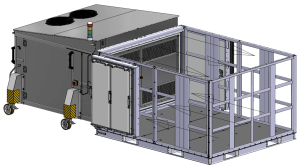Events in recent years have highlighted the important issue of transporting temperature-sensitive items around the world, in particular medicines such as vaccines. As these often have limited lifetimes, air travel is frequently the only practical option, but this raises other issues in that aircraft cannot usually carry the heavy refrigeration systems needed to maintain cold conditions indefinitely.
The current solution is to use Thermal Isolation Chambers (TICs) to carry the items. These are insulated containers with no active cooling of their own; instead, they rely on their material properties to maintain cold conditions until the items reach their destination and can be transferred to ground-based cold storage.
TICs are typically conditioned by freezing before being filled with the cargo, stacked in a shipping container and finally loaded on board the aircraft. This is a time-consuming and labour-intensive process which reduces the available duration of the flight before the contents begin to warm up. As a consequence, an air freight company approached Sharetree to see if they could help deliver an alternative solution.
Bringing the cooling to the cargo
The new approach that was trialled was to reverse the usual process: load the TICs into the shipping container, cool the container to the required temperature, and then fill the TICs with their temperature-sensitive cargo immediately before loading onboard the aircraft. To further maximise the duration at which cold conditions would be maintained, the idea was to complete the conditioning of the shipping container at a location close to the aircraft. Accordingly, Sharetree were commissioned to construct a mobile system for cooling a filled shipping container outdoors to freezer temperatures in less than 12 hours.

Their solution was essentially a large air-conditioning unit (ACU) on wheels, with dimensions that matched the doors of a standard insulated shipping container. The container’s doors were folded back to allow the ACU to be wheeled right up to the entrance. A latching mechanism then hooked behind the container’s door hinges, compressing sealing strips to ensure that ambient air could not penetrate the interface between the container and the conditioning unit. This was essential to prevent moisture entering the container, which would cause ice to form during the cooling cycle. This connecting mechanism was deliberately chosen to be very similar to the locking mechanism of the container, both for ease of use by the airport’s ground crew and to be easily adapted to suit different container designs.
A simple start/stop button was used to begin the cooling cycle, and a high volume flow of cold air then entered the container from the top set of vents, with warmer air being withdrawn at the bottom. A set of coloured lights above the unit gave a simple progress indication, ultimately turning steady blue when cooling was completed. Cooling profiles could be programmed into the ACU’s controller to suit the requirements of the cargo and the thermal properties of the container.
To test the concept, a shipping container filled with TICs was equipped with a network of thermocouples, both inside and behind TICs on all surfaces.

These showed that the temperatures inside the TICs reduced from 21°C to below –19°C in approximately 10 hours, with the change occurring most rapidly near the ceiling, as would be expected from the direction of air circulation.
